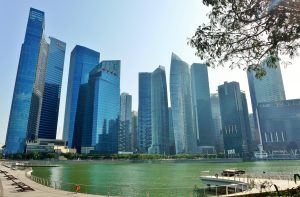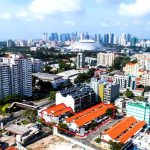More mixed-use developments expected in the CBD over the next few years
- Rejuvenating the CBD by encouraging conversions into mixed-use developments.
- Over 20 buildings with estimated 5 million sq ft, or almost half of the total private office space in Shenton Way/Tanjong Pagar precinct have been identified to qualify for the URA CBD Incentive Scheme announced in March 2019.
- Mixed-use developments allow for greater convenience and reduced commuting time for occupiers.
- Investors could derive higher blended rents and capital values than pure office buildings, while diversifying their risk.
- The pandemic has amplified the need for more mixed-use developments in the CBD, and could accelerate the conversions in the next few years.
- New CBD Grade A supply in 2020-2025 is likely to remain tight to average 3.0% of stock p.a., versus the 10-year historical average of 6.2%.
- Shenton Way/Tanjong Pagar rents to grow fastest among the micro-markets, at 2.0% and 3.4% p.a. based on a 3- and 5-year CAGR respectively.
Colliers International has published its latest research report which discusses the impact of the URA CBD incentive schemes, which was part of the Master Plan 2019, and aimed to rejuvenate the CBD by encouraging conversions into mixed-use developments.
 The CBD Incentive Scheme and Strategic Development Incentive (SDI) schemes are both part of the URA Master Plan 2019, with an aim to transform a mostly commercial downtown of today into a mixed-use downtown of tomorrow.
The CBD Incentive Scheme and Strategic Development Incentive (SDI) schemes are both part of the URA Master Plan 2019, with an aim to transform a mostly commercial downtown of today into a mixed-use downtown of tomorrow.
By blending two or more land uses such as residential, office, retail and hospitality, mixed-use developments not only allow for greater convenience and reduced commute time for occupiers, they also offer potentially higher blended rents and capital values than pure office buildings, while diversifying risks for investors.
Tricia Song, Head of Research for Singapore at Colliers International, said, ” While the takeup rate has been slow, we believe the changes in activity patterns resulting from the COVID-19 crisis such as more flexible work arrangements and telecommuting further accentuates the need for the CBD to have more mixed uses and a larger live-in population.”
Colliers Research has identified over 20 buildings with an estimated 5 million sq ft, or almost half of the total private office space in the Shenton Way/Tanjong Pagar precinct, that could qualify for the CBD Incentive Scheme. Office buildings 20-years or older on Anson Road, Cecil Street, Robinson Road, Shenton Way and Tanjong Pagar, of a minimum site area of 1,000 sqm could be eligible for gross plot ratio increases of 25%-30% if they convert into residential with commercial at the first storey, or commercial and residential, or pure hotel use.
Jerome Wright, Senior Director, Capital Markets and Investments services, added, “So far, only a handful of owners have announced redevelopment plans such as AXA Tower and Fuji Xerox Towers, and we expect more could jump onto the bandwagon over the next few years. This represents an excellent opportunity for landlords to leverage on the incentive schemes and to unlock the value of their older CBD properties.”
Colliers Research expects these schemes, if taken up, to reduce the availability of office space in the CBD and support overall rents in the near term. New CBD Grade A supply in 2020-2025 is likely to remain tight to average 3.0% of stock p.a., versus the 10-year historical average of 6.2%. In the medium term, a surge in the CBD office stock from these redevelopments is also unlikely even with the plot ratio intensification, as they are converted to mixed-use, with a reduced ratio of office stock.
Rick Thomas, Executive Director, Occupier Services, commented, “In our view, Shenton Way/Tanjong Pagar is best positioned to benefit from the schemes and undergo rejuvenation. The longer-term Greater Southern Waterfront development nearby could further uplift the Live, Work, Play concept and the precinct. Work-life balance has never been as topical as now, and by considering mixed-use developments, occupiers could address some of their key concerns such as sustainability and talent attraction.”
Colliers forecast Shenton Way/Tanjong Pagar rents to grow fastest among the micro-markets, at 2.0% and 3.4% p.a. based on a 3- and 5-year CAGR respectively.
The Urban Redevelopment Authority’s (URA) CBD Incentive Scheme is a visionary and bold plan. It offers 25-30% higher plot ratios for owners who convert office buildings over 20 years old to other complementary uses in the CBD such as residential and hotel use.
Mr Paul Ho, chief mortgage officer at iCompareLoan, said: “The CBD Incentive Scheme is visionary in its scope and bold in the significant plot ratio increases offered. The scheme will motivate several owners to convert older buildings into state-of-the-art developments with modern offices.”
One recent research noted that Singapore is already the location of choice for regional headquarters, especially for technology companies due to its quality of life and attractiveness for talent, supportive conducive government policies and funding and competitive occupancy costs. It said that it was confident this revitalisation initiative will uplift Singapore’s CBD and further widen Singapore’s lead as a top global city for talent, companies and capital.
The report by JLL said that the CBD Incentive Scheme, will help to accelerate Singapore’s decentralisation strategy to enhance sustainability, reduce commuting and enliven its decentralised gateways.
“Office occupiers displaced by the withdrawal of older office stock in the CBD will need new premises. This gives the government more scope to release land parcels outside the CBD in decentralised gateways such as Jurong East, Woodlands and Tampines to expedite the development of these hubs.
“With limited new supply of office space in the CBD expected and potential initiation of redevelopment projects, we expect CBD office rents to continue to rise over the next five years, barring any demand shocks. This would also likely widen the rental gap between CBD and suburban hubs, and motivate more businesses to consider moving some operations out of the CBD.”






